Dynamic content: How it helps you build your brand!


Today, it's no longer enough to distribute content, discount promotions or news about your brand as widely as possible on the web. If users don't feel directly addressed, they hardly pay attention to your texts, videos or landing pages. With individual and personalized content, you demonstrate interest as a brand and make your users happy. Good chances for more sales and higher conversion rates!
What are the advantages of dynamic content marketing, which forms and areas of application there are and what you should definitely consider when planning it, you can read in my brand new blog post.
{{divider}}
Fact Check: What you need to know about dynamic content
Every user is different and wants to be informed or entertained differently. Otherwise, they'll be gone in no time. Dynamic content is therefore an indispensable tool on the way to a satisfied customer. Your brand should therefore provide accurate and relevant content via various communication channels. Yes, this is time-consuming and takes work.
But: Addressing the specific needs and interests of your target group in content creation offers a huge advantage. Your company is recognized as a "problem solver" and can convince the competition. This is a big plus, especially for new brands in the retail environment that first have to prove themselves to the competition.
Dynamic content management based on the analysis of customer data and signals is the trend this year. Content on websites adapts dynamically to predefined conditions and user behavior. This way, different visitors see different content on your brand website or webshop, for example.
For example, a user who comes to your website for the first time receives a more formal greeting than your existing customers. Or the first thing they see is an explainer video about your service offering with a link to a free whitepaper download.
You can choose from the following formats:
- Blog posts or articles
- Landing page
- Newsletter or e-mail
- Google Ads
- Pictures and videos
- Product pages and category texts in web stores
- Forms (newsletter, order process)
{{divider}}
This comes before content creation:
- Know the search terms of your users (keyword analysis)
- Understand their needs, motivation and emotion and match them to the appropriate keywords
- Collect all information about customer characteristics and divide them into groups (age, profession, income, interests private, etc.)
- Analyze at which point of the customer journey your users are searching for specific terms (price comparison, model selection already made, etc.)
- Create an individual conversion path for each search query and store dynamic content for it on landing page, online store or website
{{divider}}
This is why dynamic content rocks
The key to success is personalizing what's important to the user. To deliver the right content to the right person at the perfect time, you need to gain as much knowledge about your target audience as possible. Unlike static content, dynamic content allows you to inform, entertain or add real value in a more targeted way.
If the prospect receives the shortest route to newsletter registration or suitable product recommendations along his customer journey, the bounce rate drops and the prospect is happy about the time saved during his online search for information.
Addressing prospects and customers uniquely and individually makes your brand authentic and trustworthy. Ideally, you give your website visitors the opportunity to feel at home, to participate in decision-making and to become part of a community. This builds brand trust over time, they stay longer on your website and listen attentively to your brand and product stories.
{{divider}}
Requirements to be able to build a dynamic content marketing:
- First of all: static HTML web pages are out, because you can't combine them with dynamic content.
- Your web presence is based on a content management system (CMS), store system or PHP scripting language
- Your website diligently collects information and data about the visitors via cookies or other tracking methods (be sure to pay attention to the corresponding notices in your privacy policy)
- Further data of your users are available, for example through the registration in the online store, so that you can derive special characteristics for a personalized content creation.
- You know exactly from which devices your website visitors come (Responsive Content)
- You have expert knowledge in content marketing, from defining a strategy to implementation and analysis
Do you still feel far away from expert status? Do you already know our Content Marketing Academy? Our state-approved distance learning course helps you professionalize your content marketing and score points with the right content in your target group.

{{divider}}
Forms of dynamic content: the choice is yours!
Emails and newsletters:
If you are registered on Pinterest and visit the platform regularly, you will usually receive an email once a week with suggestions for further pins on your favorite topics. As a classic means of communication, the newsletter offers many opportunities to use dynamic elements in a targeted manner and thus increase the opening rates. In addition to the salutation, the interests of your users can be collected in databases and supported with perfectly tailored mails at the appropriate point of the customer journey.
Web presence:
In contrast to a static HTML page, individual elements of dynamic websites are only generated by the server when they are called up, depending on the information stored about the user. The current time or the input of user data can also play a decisive role in what is displayed. Newcomers then see, for example, other pages and sub-pages than regular guests. From individual articles on topics the user is looking for to product suggestions, you have numerous options for customization. Testing in different directions is worth it!
Google Ads:
If you want to react dynamically to your users' search queries, you can simply create several variants of Google Ads. Usually, only the keyword is changed. From the ad, you then lead the user to a suitable landing page, which convinces with an individual text concept.
Product and category texts in online stores:
"Customers who bought this CD also bought..." We all know the popular cross-selling area in online stores or streaming services. Extremely practical and time-saving when searching for new items. By using dynamic elements in product descriptions or category texts, you have a good chance of selling your customer additional products.
Articles in online magazines:
Depending on the device, smartphone, tablet or desktop computer from which your user accesses content, it should adapt dynamically in the corporate blog or online magazine. What good is a blog post written with dedication if it is not easy to read on a mobile device? Based on posts you have already read, you can recommend further texts that match the user's personal areas of interest.
Online forms:
Oh ha, this is where the wheat is separated from the chaff. The clear advantage of dynamic forms is that they are geared to the user's goals and based on his or her experience. It's no wonder that the purchase is not completed if the user has to make annoying extra rounds in the store or the user's preferred payment method is not offered. In the retail environment, I find dynamic forms indispensable for satisfied customers.
Dynamic landing page:
The best Google ad is of no use to you if the user is directed to a landing page that does not match his search query and does not offer him any added value. You should therefore adapt the entire content of a dynamic landing page to the different needs and search queries of your users. This way, the page is difficult to copy from competitors and provides your prospects with the right solution without any detours. Of course, all this should be based on a sophisticated content marketing strategy!
{{divider}}
Numbers don't lie: Branding via Programmatic Advertising
Programmatic advertising, so to speak data-driven digital marketing, has become an indispensable part of today's marketing departments. Programmatic advertising gives you the chance to fine-tune your marketing activities and thus efficiently increase brand awareness in your target group. Dynamic content plays a key role in the individual customer approach. After all, pretty pictures are no longer enough to secure a place in the customer's relevant set. The right message match must be made and the appropriate product aspect must be highlighted in order to motivate users to make a conversion.
To this end, more and more manufacturers are turning to content creator tools that make it possible to convey target-group-specific and contextually accurate advertising messages along the user journey. The advertising media can react promptly to spontaneous events and optimally address the customer in his specific situation and mood. Brands thus once again have the opportunity for more awareness at different points of contact. Technology and creation are increasingly merging into a single unit, and campaigns can be better measured in terms of ROI than was the case a few years ago.
{{divider}}
Example: eBay Christmas campaign with dynamic real-time content
eBay Christmas commercial
Maybe you remember the last campaign of the action platform with the title: "If it happens at Christmas, it happens on eBay". Sound familiar? You've probably noticed the digital screens with dynamic advertising messages at bus and train stops in some major cities like Hamburg, Düsseldorf, Munich or Stuttgart.
The product suggestions shown were based on the movement data of a defined target group, which was disproportionately present at this touch point. With this campaign, eBay clearly focused on the needs of its customers and demonstrated that it was the online platform with its finger on the pulse. Subsequent reporting proved that sales of the products displayed had increased significantly during the campaign period.
{{divider}}
My conclusion
Dynamic content makes your customers happy and satisfied. But only if you know how your users feel, think, and what motivates them to search online for specific terms, can you engage them with your brand along the customer journey. Improved customer experience, less frustration with search queries and therefore a good readiness for conversions. All of these are the best prerequisites for building a strong brand with the help of dynamic content.
Dynamic content: How it helps you build your brand!
contentbird.blog






